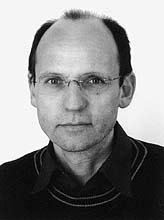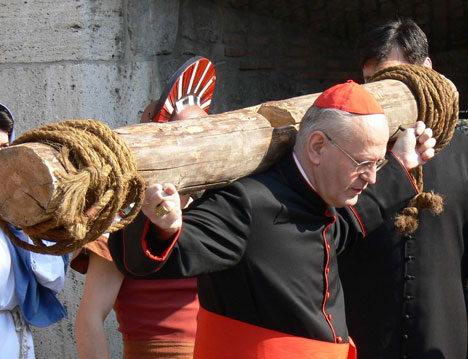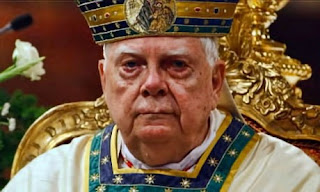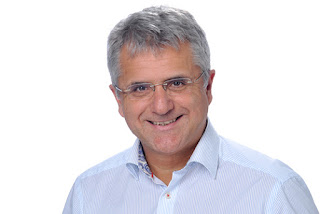Extraordinary form for monstrance to take in Linz - article from 2019
New Monstrance for Goldwörth
The last time something like this happened in the Diocese of Linz was several decades ago: In Goldwörth (Urfahr district), a new monstrance was blessed on Sunday after the old one was stolen.
There was great anger when a Romanian trio of burglars stole the monstrance from the parish hall in Goldwörth in September 2017. Since the valuable object never reappeared even after the perpetrators were arrested, a new one was commissioned.
Roman Pfeffer, who comes from Attnang-Puchheim (Vöcklabruck district) and lives in Vienna, brought his work directly from Vienna to the service in the Parish church in Goldwörth (Urfahr district) for blessing and presented it to Pastor Josef Pesendorfer.
A special moment for Father Josef Pesendorfer – he also celebrated his 80th birthday on Sunday.
"A very special material"
Pfeffer, who was awarded the Dagmar Chabot Sculpture Prize in October 2018, chose a combination of bog oak and bronze. "The approximately 2,000 to 3,000-year-old, black and petrified wood, which was buried in a bog and discovered during excavations, is a very special material that emerged from a catastrophe," the artist explained in an interview with ORF OÖ.
It is not the only work Roman Pfeffer has been commissioned to create for Goldwörth. The parish church was severely damaged in the flood of June 2013 and redesigned "from the ground up" by the artist. The precious wood of the rare bog oak was also used for the altar.
Impressive openness to art
"I am impressed by the parish's openness and great commitment to contemporary art," said Pfeffer. The Goldwörth "host heart showpiece" is reminiscent of a loaf of bread with its round shape, and the grooves in the wood are reminiscent of the breaking of bread, according to the artist. The monstrance, stripped down to its essentials and without the host at its center, bears nothing in common with the object stolen two years ago. It will be carried through the town for the first time during the Corpus Christi procession on Thursday.
Background from the Diocesan Magazine
In September 2017, the Goldwörth rectory was burglarized. In addition to money, several monstrances were stolen. The thieves were caught, but the liturgical items remained missing. The parish didn't want a "run-of-the-mill" monstrance from a catalog, so they commissioned the artist Roman Pfeffer to create a new one. True to the motto: Living faith today also requires art from our time. The monstrance he designed is not only new, but also atypical.
 |
| The parish altar |
Bog oak and bronze
Roman Pfeffer used bog oak as the material. This wood is 2,000 to 3,000 years old, was buried, and was discovered during excavations; the fossilization process had already begun. Bog oak was also used in the design of the church interior and corresponds to the history of the parish, which has been repeatedly affected by flooding.
From the Centre
Not only is the material unusual – bog oak on the front and bronze on the back, but also the positioning of the moon-shaped clamp – the "lunula" – for the host. The golden clamp holds the host, the "Body of Christ." It is usually placed in the center. Pfeffer positioned it to the side, moving it from the center to the edge. For Father Josef Pesendorfer, this is an essential symbol: "Jesus came into the world, became one of us, just like us. He reached out especially to people on the margins of society." This interpretation seems convincing. The newly created work remains open to many other interpretations.
A Loaf of Bread
It is also intriguing that the monstrance itself is shaped like a loaf of bread. The wood grain, resembling cracks from the breaking of bread, is clearly visible on the front. The bronze back is reminiscent of a fresh loaf of bread. Metals such as bronze or gold represent the sacred or divine. The dark surface of the bog oak makes the light-colored host stand out more clearly, and the contrast is clearly visible even from a distance.
In front of the body
The monstrance is not attached to a rod and held aloft, as is usually the case, but is carried in front of the body – in the center of the body. The words spoken in the liturgy: "Take and eat, this is my body" thus take on a new dimension. Roman Pfeffer says: "The handling is derived from the shape. The circular form is to be seen as a unit. This should not be interrupted by a stand or rod, which would actually be merely additional accessories. The monstrance is reduced to its essentials." The new monstrance will be used for the first time in Goldwörth on Corpus Christi.
About the artist
Roman Pfeffer, born in 1972, is an internationally recognized artist from Vöcklabruck. He lives and works in Vienna, where he studied at the Academy of Fine Arts and the Kent Institute in Canterbury, England. In 2013, he won the main prize at the Austrian Graphic Arts Competition, and in 2018, he received the Dagmar Chobot Sculpture Prize. He has exhibited his work in many European countries.
Is it something in the Danube water....Goldwörth is on the Northern bank. 20 km downstream a decade earlier, the famous Linz monstrance was deployed.











.jpeg)

Comments